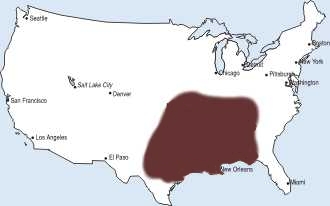Tips about spider´s location
The brown recluse spider, as well as other species of Loxosceles, is a native of the USA. Nevertheless, other non-native species can be found in a small number of areas in the country, such as the Loxosceles spider rufescens or Mediterranean recluse. Brown recluse spiders are mainly found in the central Midwestern states southward to the Gulf of Mexico, especially in Oklahoma, Arkansas and Missouri. Important: these spiders can and do spread, travelling inside boxes and packaging.
|
Inside homes, the brown recluse spider can be found in any of the following places: dark spots within baths, dormitories, garages, closets and cellars, vent and heating conducts, seldom used clothes/shoes. They can nest in stored clothes, old books, boxes, furniture, toys, carpets, coatings, corners and cracks.
Typical outdoor habitats of the brown recluse spider: storage places, underneath rocks or inside hollow trunks. |
These are common spiders hiding spots:
For more inside aspects, please read the article below.
Spider Location by B. Gilmore
The Brown Recluse Spider (recluse Loxosceles) is spread all over the territory of the United States of America and its bite injects a strong and harmful poison.
The length of the Brown Recluse Spider body or “corner spider” is between 8 and 12 mm, reaching, with its legs stretched, 45 mm. Its color is brown and its cephalothorax is lighter than the abdomen. It also has a dark stain with the shape of a violin and the base heads forward.
The male has a similar length but its body and legs are thinner. It has been found in 41% of urban houses and 24% of rural places.
Houses are the common habitat of this kind of spider. Shy, lonely and sedentary, the brown recluse spider develops its activity during the night. It can be found in buildings, weaving its web in high and dark corners and behind paintings or closets.
The bite of this spider is just a self defense mechanism. We can find it throughout the year but most cases occur in summer and spring. The bite, in general, is the result of pressing the spider with the skin during the night when the person sleeps (38%), or when people get dressed (32%) with clothes that were hung on walls or closets for a long time. Normally, the bite can be found on the face and the extremities. The spider is seen in the 60% of the cases but only identified in 13% of them. |
 |
The medical profile caused by the Loxosceles spiders is known as loxoscelism and takes two clinic descriptions:
- Skin Loxoscelism (around 90% of the cases) and
- Skin-Visceral Loxoscelism
It is of the utmost importance to control any type of Loxoscelism within the first 24 or 48 hours and being on the alert for the appearance of symptoms or any kind of signs that may suggest a visceral case.
|
